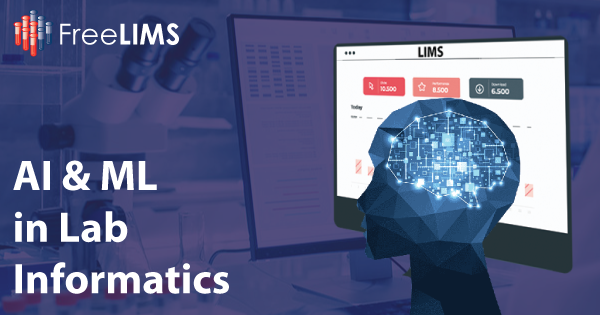In the world of laboratory informatics, where data management and scientific workflows reign supreme, the integration of Artificial Intelligence (AI) and Machine Learning (ML) is paving the way for unprecedented advancements. Laboratories are discovering the immense potential of these technologies to streamline processes, enhance decision-making, and unleash the true power of their data. The day is not far when laboratory operations will no longer rely on conventional manual input methods and dropdown selections. Instead, imagine a future where laboratories enable users to make requests using voice commands. Picture a scenario where a clinician issues the instruction, “Please log the sample type from XYZ clinic,” and AI dutifully carries out the task. This advancement has the potential to streamline daily tasks and significantly simplify laboratory operations. This blog delves into four ways AI and ML in laboratory informatics can enhance efficiency, accuracy, and innovation in modern laboratories.
- Enhancing lab instrumentation: Instrument downtime can impose substantial financial burdens on laboratories, especially when it occurs unexpectedly. However, employing ML makes it possible to establish correlations with system failures. This analysis can help forecast the necessity for preventive maintenance, potentially mitigating instrument downtime and its associated costs. Such functionality can be integrated into instruments and software systems like LIMS, ELN, Scientific Data Management Systems (SDMS), and instrument control software. Combining this with instrument telemetry data such as oven temperature or pump pressure effectively eliminates the majority of unscheduled maintenance events.
- Improving data integrity: In most labs, the checks implemented to enhance data integrity or address issues are typically not performed in real time. For instance, the review of audit trails is often conducted monthly or quarterly, and the process can be laborious, increasing the likelihood of overlooking discrepancies when analyzing extensive logs of system changes. This is where the marriage of AI, ML, and LIMS can prove instrumental. LIMS, as the cornerstone of efficient lab operations, is perfectly positioned to benefit from cutting-edge technologies such as AI and ML. A LIMS documents every lab operation, accompanied by timestamps indicating the date and time, the responsible individuals, and the purpose behind each activity. ML can monitor the real-time audit trails of informatics systems and instruments. At the same time, AI can identify and report any unusual actions or trends in results that deviate from the norm to managers.
- Tracking consumption of lab inventory: Efficient monitoring of daily lab consumables, such as glassware and reagents, is crucial for laboratories. Presently, many labs rely on predetermined rules set by users to manage expiry dates and reorder levels. However, by harnessing the power of AI, laboratories can delve into historical consumption data to establish customized rules that align with actual usage patterns. AI-infused Laboratory Informatics Management systems can go a step further. In situations where a particular consumable is unavailable for an experiment, AI can offer suggestions for suitable alternatives already present in the lab, eliminating the need to place new orders and wait for potential supply chain complications to be addressed.
- Making stability studies more efficient: A LIMS software plays a pivotal role in effectively managing stability studies by providing comprehensive support throughout the process. It aids in maintaining and organizing stability study data, automating data entry, and ensuring regulatory compliance. Additionally, a LIMS helps in tracking sample storage conditions, monitoring stability study timelines, and generating accurate and detailed reports.
Integrating AI and ML techniques in LIMS can bring substantial benefits to stability studies, revolutionizing how data is analyzed and interpreted. AI algorithms have the capability to analyze vast amounts of data from stability studies, including environmental conditions, sample attributes, and analytical results. ML models can identify patterns, correlations, and anomalies in the data, enabling faster and more accurate analysis, accelerating decision-making processes, and improving overall study efficiency. That’s not all. One of the most groundbreaking applications of AI and ML in stability studies facilitated by LIMS lies in the development of predictive models. Predictive models that forecast the stability and degradation of product samples over an extended period can also be developed using AI and ML in LIMS. By considering multiple variables, such as temperature, humidity, and exposure to light, these models can provide valuable insights into the long-term behavior of product samples. This empowers researchers to optimize storage conditions and identify potential issues before they occur.
What’s more, AI and ML in LIMS can help reduce the duration of studies. Stability studies come at a high cost and require an extended duration before conclusive results can be obtained. By harnessing AI and ML, optimizing the duration of these studies is possible. A targeted approach of pinpointing the essential attributes allows for early detection of issues and accurate prediction of potential failures. The integration of AI and ML within LIMS effectively trims down study durations, conserving resources and expediting the path to actionable results.
Conclusion
Integrating AI and ML in laboratory informatics is poised to revolutionize lab operations. With enhanced workflows, automation, and advanced data analysis capabilities, AI-driven laboratories are set to unleash the full potential of their data and transform scientific research and analysis. The benefits of AI and ML in laboratory informatics are vast, from making stability studies more efficient and predictive to enhancing lab instrumentation and improving data integrity. Through preventive maintenance, laboratories can expect streamlined processes, faster decision-making, and reduced costs. Moreover, AI-powered systems can track the consumption of lab inventory, suggest alternatives, and optimize resource utilization.
The future holds immense possibilities for laboratories that embrace these technologies and harness their potential to drive scientific advancements.


